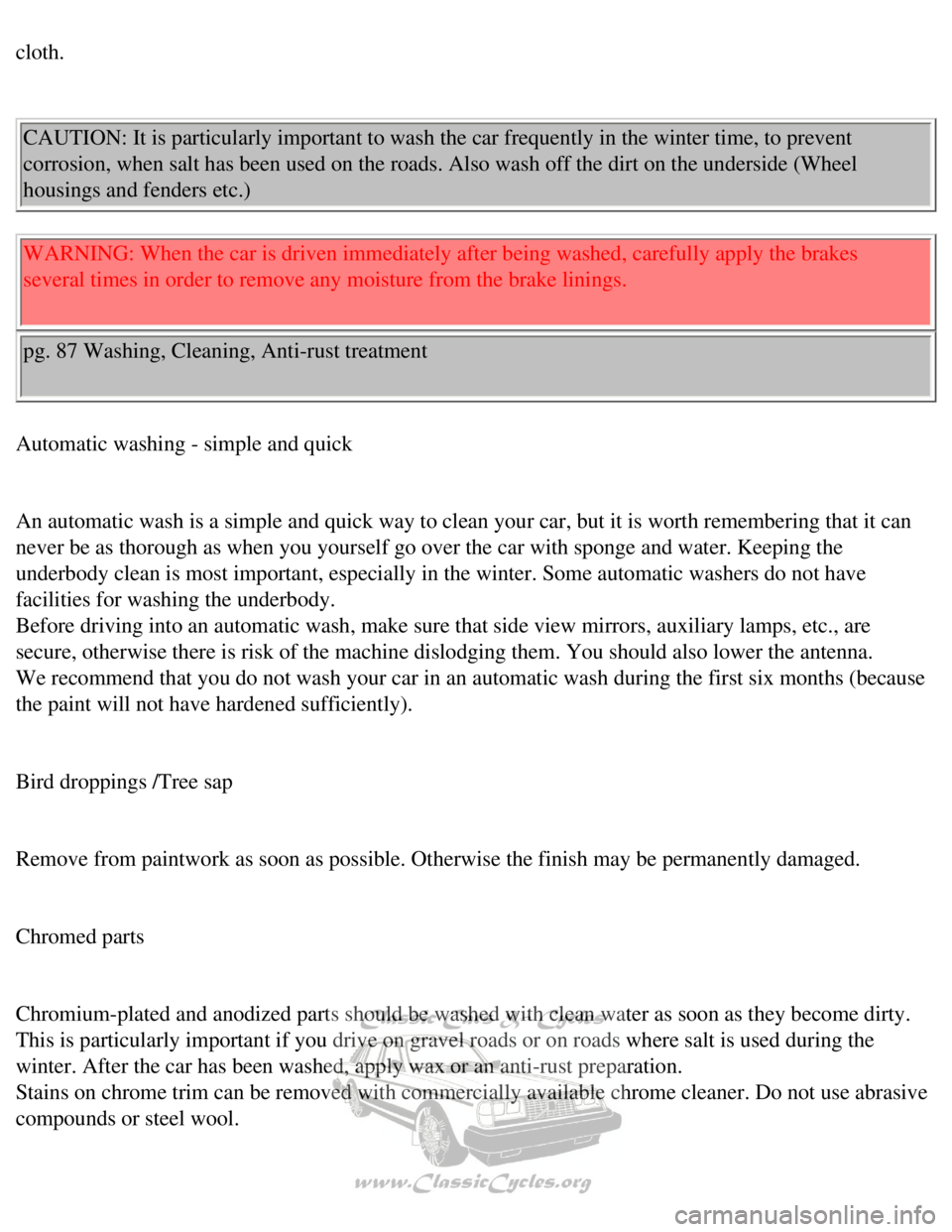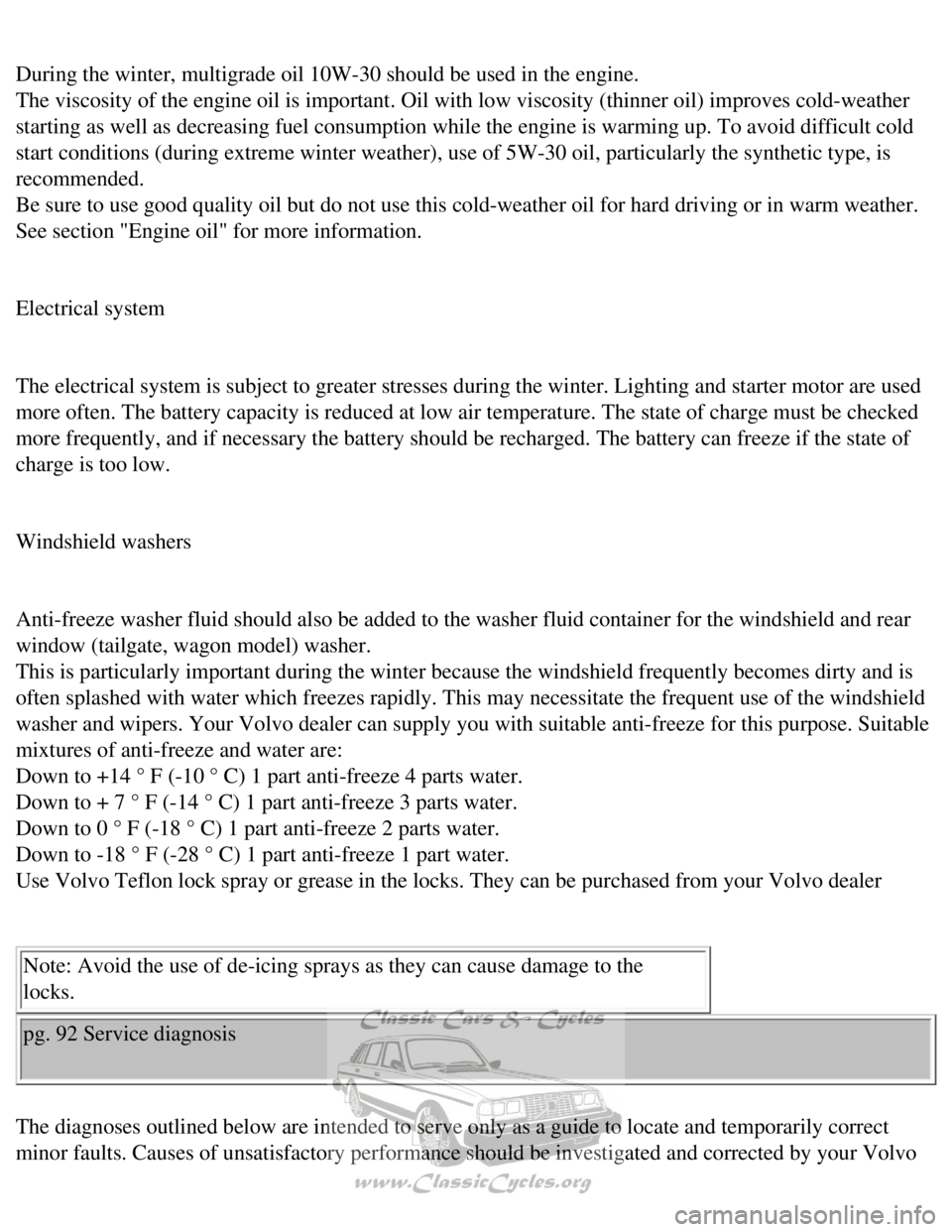Page 113 of 143

Volvo 1990 240 Model
pg. 82 Wheels and tires
Checking and correcting tire pressure
Check the tire pressure when refueling. The tire pressure should only be\
corrected when the tires are
cold. With warm tires, correct only when the pressure is too low. The ti\
re temperature (and, thus,
pressure) rises after driving just a few miles.
Warning: Improperly inflated tires will reduce tire life, adversely affe\
ct vehicle handling and can
possibly lead to failure resulting in loss of vehicle control without pr\
ior warning.
Vehicle Loading
The tires on your Volvo will perform to specifications at all normal loa\
ds when inflated as
recommended on the tire information label located on the rear facing sid\
e of the right front door. This
label lists both tire and vehicle design limits.
Do not load your car beyond the load limits indicated.
Tire Pressure Label
The tire pressure label is located on the rear facing side of the right \
front door.
See section titled ''Specifications'' and Consumer Information Booklet f\
or complete tire pressure
information.
Wear indicator
The tires have a so-called "wear indicator in the form of a number of na\
rrow strips running across or
parallel to the tread. When approx 1/16 " (1.5 mm) is left on the trea\
d, these strips show up and indicate
the tire should be replaced.
Tires with less than 1/16" (1.5 mm) tread have a very poor grip in rai\
n or snow.
pg. 83 Wheels and tires
file:///K|/ownersdocs/1990/1990_240/90240_17.htm (1 of 2)12/30/2006 8:\
25:10 AM
Page 114 of 143
Volvo 1990 240 Model
General
When replacing worn tires, it is recommended that the tire be identical \
in type (radial) and size as the
one being replaced. Using a tire of the same make (manufacturer) will \
prevent altering the driving
characteristics of the vehicle.
How to improve tire economy
l Maintain correct tire pressure
l Drive smoothly: avoid fast starts, hard braking and tire screeching.
file:///K|/ownersdocs/1990/1990_240/90240_17.htm (2 of 2)12/30/2006 8:\
25:10 AM
Page 116 of 143

Volvo 1990 240 Model
cloth.
CAUTION: It is particularly important to wash the car frequently in the \
winter time, to prevent
corrosion, when salt has been used on the roads. Also wash off the dirt \
on the underside (Wheel
housings and fenders etc.)
WARNING: When the car is driven immediately after being washed, carefull\
y apply the brakes
several times in order to remove any moisture from the brake linings.
pg. 87 Washing, Cleaning, Anti-rust treatment
Automatic washing - simple and quick
An automatic wash is a simple and quick way to clean your car, but it is\
worth remembering that it can
never be as thorough as when you yourself go over the car with sponge an\
d water. Keeping the
underbody clean is most important, especially in the winter. Some automa\
tic washers do not have
facilities for washing the underbody.
Before driving into an automatic wash, make sure that side view mirrors,\
auxiliary lamps, etc., are
secure, otherwise there is risk of the machine dislodging them. You shou\
ld also lower the antenna.
We recommend that you do not wash your car in an automatic wash during t\
he first six months (because
the paint will not have hardened sufficiently).
Bird droppings /Tree sap
Remove from paintwork as soon as possible. Otherwise the finish may be p\
ermanently damaged.
Chromed parts
Chromium-plated and anodized parts should be washed with clean water as \
soon as they become dirty.
This is particularly important if you drive on gravel roads or on roads \
where salt is used during the
winter. After the car has been washed, apply wax or an anti-rust prepara\
tion.
Stains on chrome trim can be removed with commercially available chrome \
cleaner. Do not use abrasive
compounds or steel wool.
file:///K|/ownersdocs/1990/1990_240/90240_18.htm (2 of 8)12/30/2006 8:\
25:11 AM
Page 117 of 143

Volvo 1990 240 Model
Polishing (waxing)
Normally, polishing is not required during the first year after delivery\
. Waxing may be beneficial.
Before applying polish or wax the car must be washed and dried. Tar spot\
s can be removed with
kerosene or tar remover. Difficult spots may require a fine rubbing comp\
ound.
After polishing use liquid or paste wax.
Several commercially available products contain both polish and wax. Wax\
ing alone does not substitute
for polishing of a dull surface.
A wide range of polymer based car waxes can be purchased today. The waxe\
s are easy to use and
produce a long lasting high gloss finish which protects the bodywork aga\
inst oxidation, road dirt and
fading.
Cleaning the upholstery
Generally the fabric can be cleaned with soapy water or a detergent. For\
more difficult spots caused by
oil, ice cream, shoe polish, grease, etc., use a stain remover.
The plastic in the upholstery can be washed.
To clean leather upholstery , use soft cloth and mild soap solution, for\
instance common bath soap.
For more difficult spots, consult an expert for the choice of cleaning a\
gent.
On no account must gasoline, naphtha or similar cleaning agents be used \
on the plastic or the leather
since these can cause damage.
When aging, leather changes appearance, but the typical texture remains.\
To preserve smoothness and
appearance, it is recommended to treat the leather with a special leathe\
r preservative after one or two
years of use.
Cleaning the seat belts
Clean only with luke warm water and mild soap solution.
WARNING! Do not use cleaning solvents to clean the seat
belts.
Cleaning floor mats
file:///K|/ownersdocs/1990/1990_240/90240_18.htm (3 of 8)12/30/2006 8:\
25:11 AM
Page 124 of 143

Volvo 1990 240 Model
During the winter, multigrade oil 10W-30 should be used in the engine. \
The viscosity of the engine oil is important. Oil with low viscosity (t\
hinner oil) improves cold-weather
starting as well as decreasing fuel consumption while the engine is warm\
ing up. To avoid difficult cold
start conditions (during extreme winter weather), use of 5W-30 oil, pa\
rticularly the synthetic type, is
recommended.
Be sure to use good quality oil but do not use this cold-weather oil for\
hard driving or in warm weather.
See section "Engine oil" for more information.
Electrical system
The electrical system is subject to greater stresses during the winter. \
Lighting and starter motor are used
more often. The battery capacity is reduced at low air temperature. The \
state of charge must be checked
more frequently, and if necessary the battery should be recharged. The b\
attery can freeze if the state of
charge is too low.
Windshield washers
Anti-freeze washer fluid should also be added to the washer fluid contai\
ner for the windshield and rear
window (tailgate, wagon model) washer.
This is particularly important during the winter because the windshield \
frequently becomes dirty and is
often splashed with water which freezes rapidly. This may necessitate th\
e frequent use of the windshield
washer and wipers. Your Volvo dealer can supply you with suitable anti-f\
reeze for this purpose. Suitable
mixtures of anti-freeze and water are:
Down to +14 ° F (-10 ° C) 1 part anti-freeze 4 parts water.
Down to + 7 ° F (-14 ° C) 1 part anti-freeze 3 parts water.
Down to 0 ° F (-18 ° C) 1 part anti-freeze 2 parts water.
Down to -18 ° F (-28 ° C) 1 part anti-freeze 1 part water.
Use Volvo Teflon lock spray or grease in the locks. They can be purchase\
d from your Volvo dealer
Note: Avoid the use of de-icing sprays as they can cause damage to the
locks.
pg. 92 Service diagnosis
The diagnoses outlined below are intended to serve only as a guide to lo\
cate and temporarily correct
minor faults. Causes of unsatisfactory performance should be investigate\
d and corrected by your Volvo
file:///K|/ownersdocs/1990/1990_240/90240_19.htm (2 of 7)12/30/2006 8:\
25:13 AM
Page 139 of 143
Volvo 1990 240 Model
Overdrive off (auto
trans.) 1.2 W
W2x4.6d 1
Warning flashers 1.2 W W2x4.6d 1
El. heated window 1.2 W W2x4.6d 1
Seat belts 2 W Ba 9 s 2
Bulb failure 1.2 W W2x4.6d 1
pg. 103 Specifications
Recommended max. and min. speeds†, mph (km/h)
Manual transmission M47 II
1st gear 2nd gear 3rd gear 4th gear 5th gear
-25 (-
40) 10-44 (20-
70) 20-70 (30-
110) 25-
(44-) 44-
(70-)
† always observe posted speed limits.
Vehicle Loading
The tires on your Volvo will perform to specifications at all normal loa\
ds when inflated as
recommended on the tire information label located on the rear facing sid\
e of the right front door.
This label lists both tire and vehicle design limits.
Do not load your car beyond the load limits indicated.
file:///K|/ownersdocs/1990/1990_240/90240_20.htm (10 of 14)12/30/2006 \
8:25:15 AM